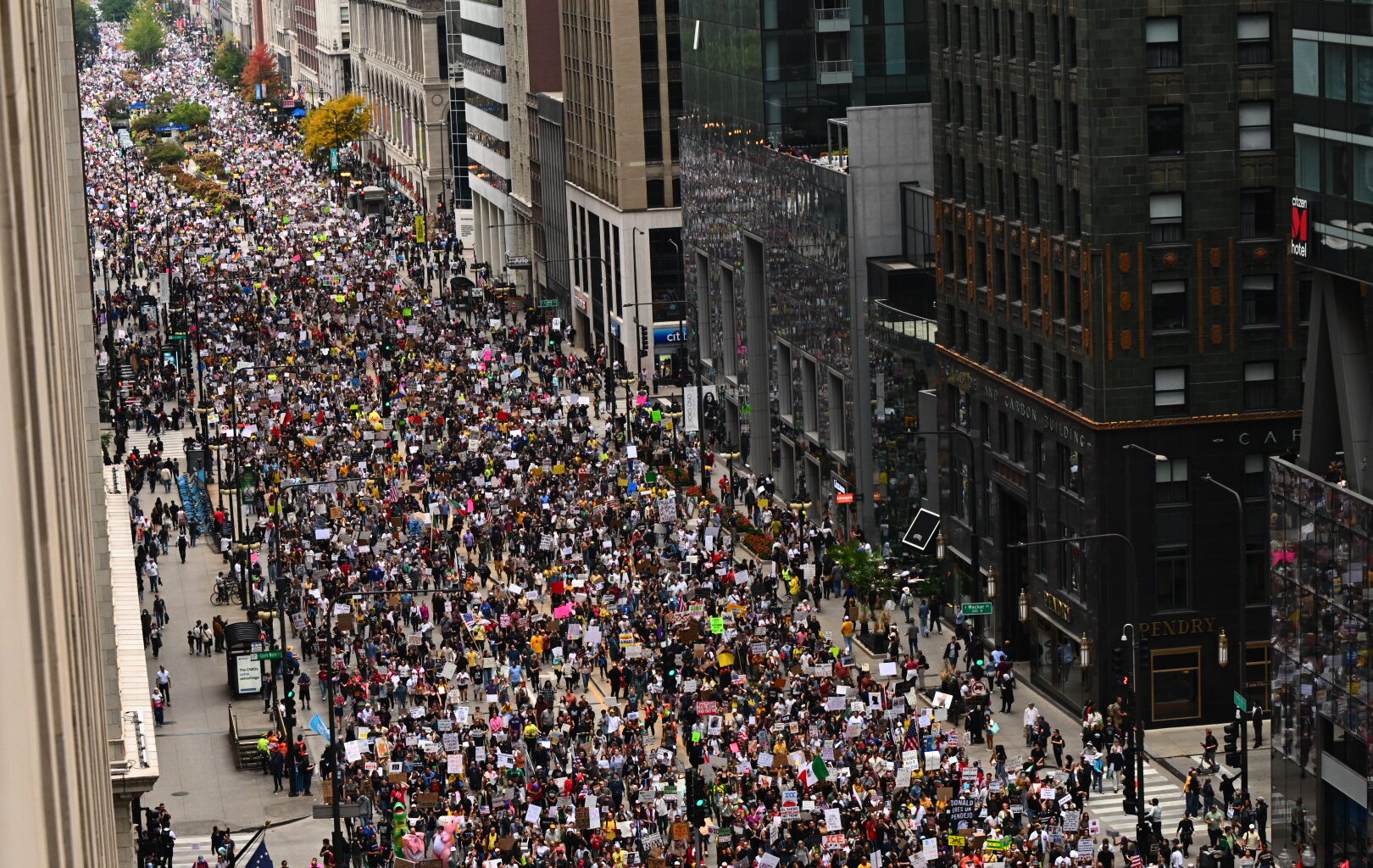Overview:
As many as 250,000 Chicagoans flooded Downtown on Saturday to condemn Donald Trump’s administration as part of the second nationwide No Kings protest
DOWNTOWN — With their city caught in the country’s largest immigration enforcement operation, as many as 250,000 Chicagoans flooded Downtown on Saturday to condemn Donald Trump’s administration as part of the second nationwide No Kings protest.
At one point, the march stretched a full two miles, from south of Washington Boulevard up Michigan Avenue to Wacker Drive and back south along Clark Street and Jackson Boulevard to Grant Park’s Butler Field, where it had begun hours earlier.
Organizers estimated that 250,000 people joined the march, according to Sally Schultze, a spokesperson for Indivisible, one of the groups that organized the event. The Chicago No Kings protest in June drew an estimated 75,000 people. A Chicago Police Department spokesperson said that there were “a lot” of people in the crowd, but reiterated the department’s longstanding policy of declining to give public crowd estimates.
Police said no one was arrested in connection with the rally or march.
Saturday’s event kicked off about noon with a rally in Butler Field at the Petrillo Music Shell. Well before the rally began, thousands of people converged on the lakefront park and settled in to hear from speakers including Gov. JB Pritzker and Mayor Brandon Johnson.
Pritzker walked out to chants of “JB!” from the crowd, which packed the field from end to end.
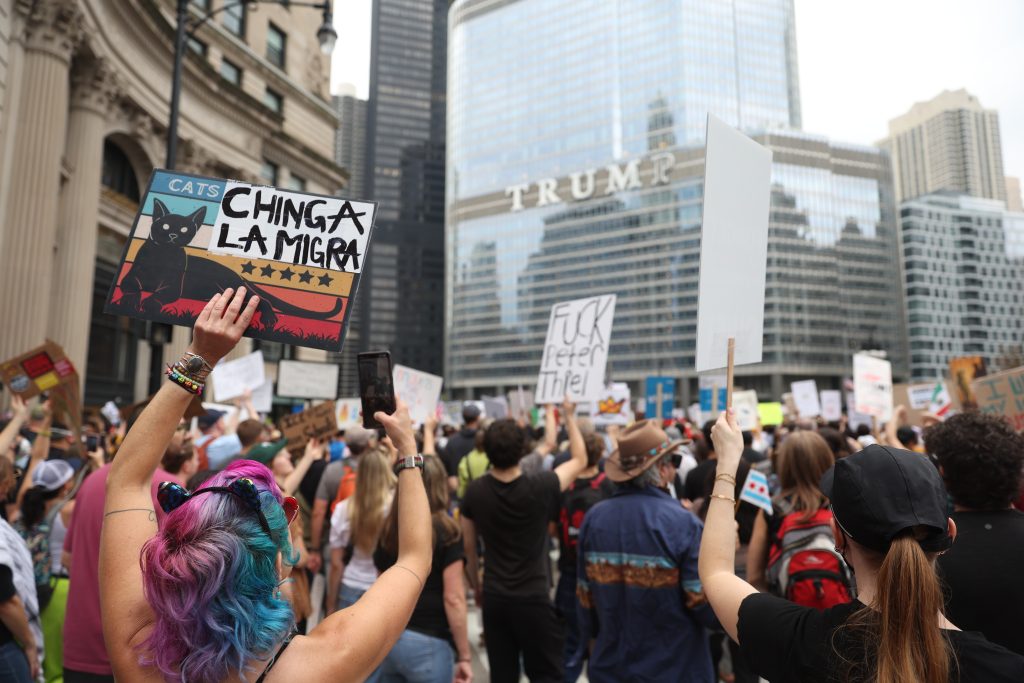 Tens of thousands march through Downtown during a No Kings protest in Chicago on Oct. 18, 2025. Credit: Talia Sprague
Tens of thousands march through Downtown during a No Kings protest in Chicago on Oct. 18, 2025. Credit: Talia Sprague
“We will never surrender!” the governor said. “Throughout history we have learned that tyranny doesn’t arrive with dramatic proclamations. We learned that it comes wrapped in ‘law and order’ … The reality here in Chicago is this: Black and Brown people are being targeted for the color of their skin. Children are being zip-tied and separated from their families … These people are not abstractions. They pay taxes on their businesses. They work hard — these people are the fabric of our society.”
As “U.S.A!” chants erupted through the crowd, Pritzker called on Chicagoans to come together in the face of the Trump administration’s actions.
“Peaceful, democratic resistance is always scary for authoritarians,” Pritzker said. “We in Chicago are not afraid to stand up … Today we are resisting more than just Donald Trump’s attacks on democracy, and he knows it.”
“They want a rematch of the Civil War,” Johnson said to the crowd. “But we are here to stand firm, to stand committed — that we will not bend. We will not cower. The attempt to divide and conquer this nation will not prevail, because when the people are united, justice always prevails.”
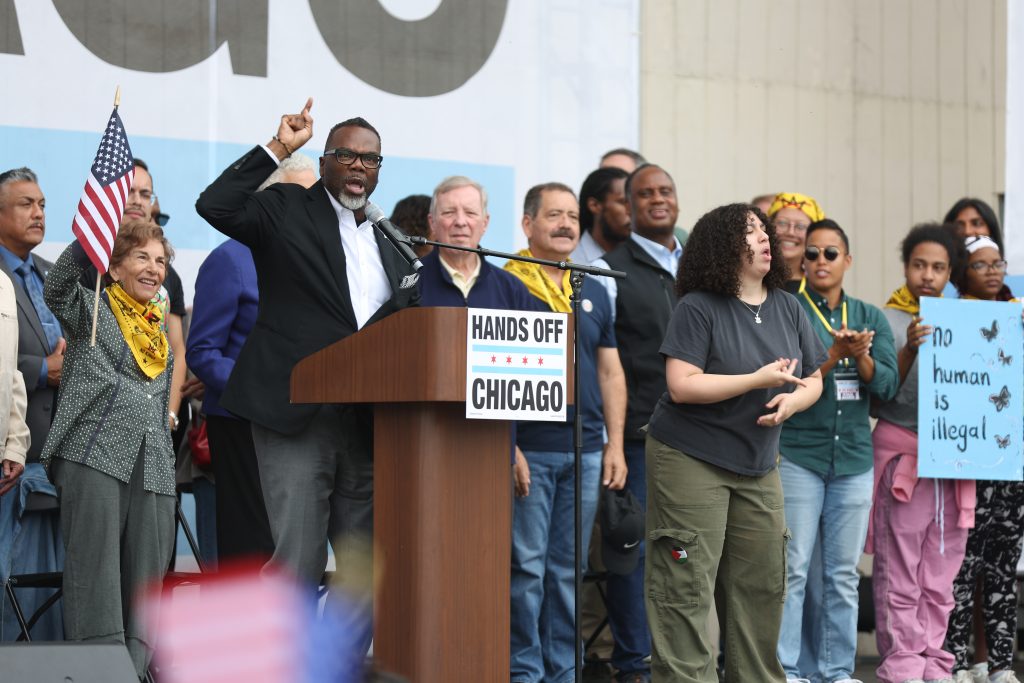 Mayor Brandon Johnson speaks at the No Kings protest at Butler Field in Downtown Chicago on Oct. 18, 2025. Credit: Talia Sprague for Block Club Chicago
Mayor Brandon Johnson speaks at the No Kings protest at Butler Field in Downtown Chicago on Oct. 18, 2025. Credit: Talia Sprague for Block Club Chicago
Carrying hand-lettered signs with slogans including “When injustice becomes law, resistance becomes duty,” “No crown for the orange clown” and “Hate does not make America great,” the crowd spilled out onto Downtown streets after 1 p.m. Despite some initial confusion in the crowd about the route, the destination was a usual one for anti-Trump rallies: Wacker Drive across from Trump Tower, 401 N. Wabash Ave. After rallying there, the crowd circled back to Butler Field.
Chicago’s demonstration was one of many No Kings protests to be held Saturday across the United States. The Downtown rally sought to show President Donald Trump and his administration that there is unified opposition to “illegal and unnecessary attacks against our neighbors, our communities and our democracy,” according to an organizing page.
Many of those at the Chicago march Saturday said they were there to represent others who might be too afraid of being targeted to attend.
“It’s my duty to do this as a Mexican American who has citizenship here,” one protester, a Chicago resident named Paulina, said. “I’ve been seeing a lot of terrifying realities on social media and it’s easy to let that fear take over my life. But now that I’m here, seeing protesters of all ages and abilities, it takes the fear out.”
As a line of police officers with bicycles ushered demonstrators north on Michigan Avenue, bystanders on the sidewalk cheered on the protest.
Kurt, a Brighton Park resident who declined to share his last name for safety reasons, said that Saturday’s protest was the first he’d attended since 1990 protests against the Gulf War. He was inspired to go to the march after being hit with tear gas in his neighborhood, he said.
“That’s why I’m here,” he said. “They’re kidnapping people off the streets — in my neighborhood — and it feels like a ghost town. People are scared, I’m scared too, but I’m mostly angry. History is repeating itself and this feels like Nazi Germany. I mean, I’m carrying my birth certificate around with me nowadays just out of fear of what they might do.”
Demonstrators carried a 75-foot long copy of the U.S. Constitution through the streets as hundreds waved American flags.
Compounded with chants of “U.S.A!” and signs echoing the importance of preserving freedom, many protesters said they were rallying against ideas and policies threatening the foundational principles of the United States.
“We need to save America!” one sign read.
Others displayed their American flags upside down — a display that is meant as a “signal of dire distress,” according to the U.S. Code.
Demonstrators came prepared with creative, homemade costumes and signs that mocked President Trump and others in his administration, including Homeland Security Secretary Kristi Noem, who accompanied masked federal agents on raids in Chicago earlier this month.
Dozens of protesters came out in costumes or inflatable suits, ranging from giraffes to unicorns to axolotls, apparently taking inspiration from protesters in Portland.
Alissa, who declined to share her last name for safety reasons, dressed up in a tiger costume and was joined by her friend Linda, who wore an inflatable unicorn suit.
Their costumes were meant to “make it a little more lighthearted” and poke fun at Republican leaders who have described protestors as violent or aggressive, Alissa said.
One group of protesters, some dressed in inflatable costumes, brought a custom-made piñata decorated to look like an ICE agent to Saturday’s march.
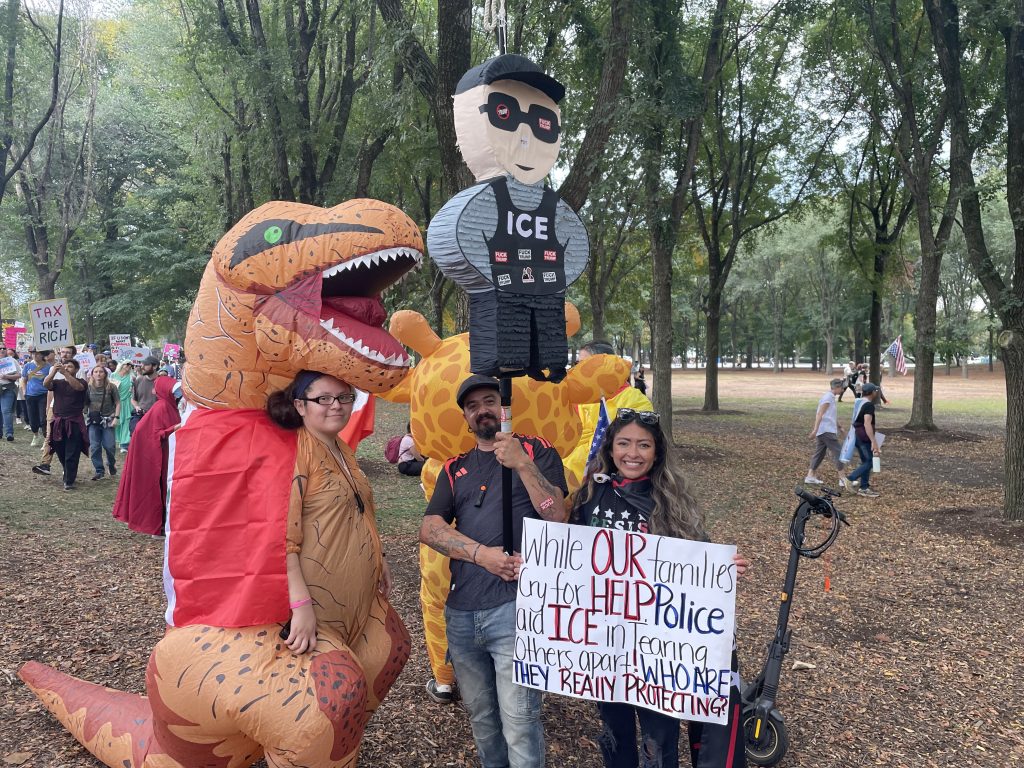 Protesters ChicanaReina, dressed in a dinosaur costume, Francisco and Oli, who declined to share their last names for safety reasons, brought a piñata decorated as an ICE agent to Saturday’s No Kings march. Credit: Grey Lucas
Protesters ChicanaReina, dressed in a dinosaur costume, Francisco and Oli, who declined to share their last names for safety reasons, brought a piñata decorated as an ICE agent to Saturday’s No Kings march. Credit: Grey Lucas
“We’ve all been protesting at Broadview, so we’ve been there and seen everything firsthand as far as how these savages are behaving,” a protester from West Chicago named Oli said. “So, people get to punch him and then there’s treats in there eventually.”
Oli, who along with her friends declined to have her last name used because of safety concerns, said she and her friends started going to the ICE detention center in Broadview to protest after seeing how federal agents were treating other immigrants in the Chicago area.
“There’s masked men going in and kidnapping people off the streets, out of school parking lots and drop-off lines, people’s work, their homes,” she said. “I come from a family of immigrants. I’m actually an immigrant myself so I have the voice and the ability to be out here and spread awareness so that’s what motivates me.”
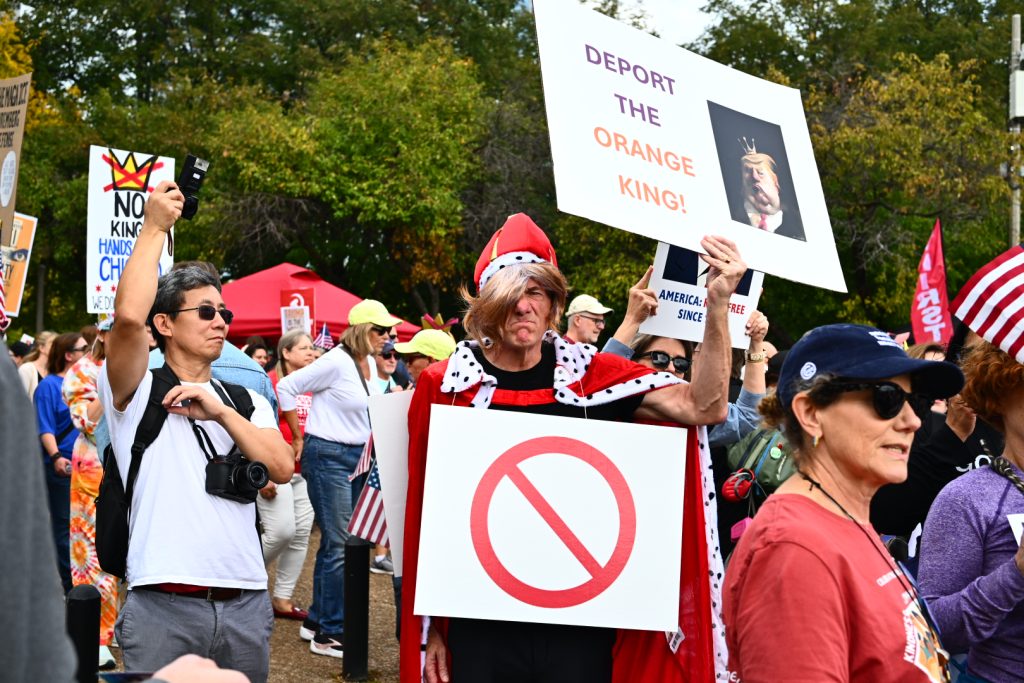 Thousands gather for the No Kings protest at Butler Field in Downtown Chicago on Oct. 18, 2025. Credit: Colin Boyle/Block Club Chicago
Thousands gather for the No Kings protest at Butler Field in Downtown Chicago on Oct. 18, 2025. Credit: Colin Boyle/Block Club Chicago
In the hours leading up to Saturday’s rally, all modes of transit heading downtown were clogged. Hundreds packed into train cars. On the O’Hare branch of the Blue Line, south of California, riders had to wait for several trains to pass by before being able to get on the train, protesters said. Bridges were lifted starting around 9 a.m. Saturday for Chicago’s annual fall boat runs, further congesting some downtown streets.
The protest and march come as the Trump administration’s large-scale immigration operations in Chicago — ICE’s Midway Blitz and Customs and Border Patrol’s At Large — are well into their second month. More than 1,000 people have been arrested during Operation Midway Blitz, Russell Hott, former ICE field director in Chicago, told Block Club earlier this month.
Since the operations began, federal agents in and around Chicago have shot at least two people, killing one; repeatedly tear-gassed protesters and first responders; shot rubber bullets at protesters; detained U.S. citizens, including children; handcuffed a Chicago alderperson in a hospital; smoke-bombed and tear-gassed people in Logan Square, Albany Park and East Side; fired a chemical weapon at a TV reporter and detained a journalist.
Listen to the Block Club Chicago podcast:

